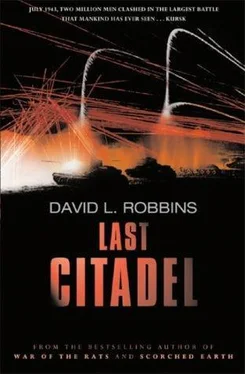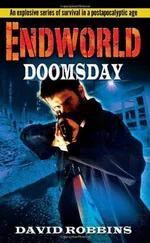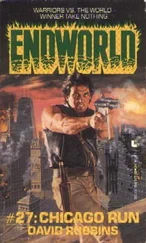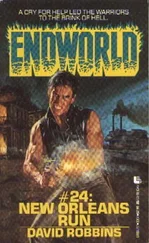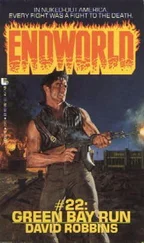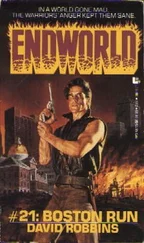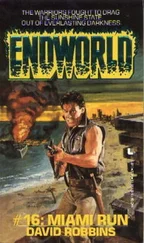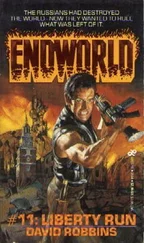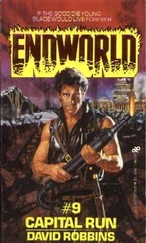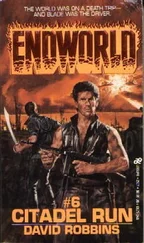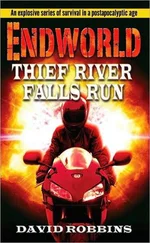‘Fire.’
The gunner muttered, ‘Away,’ and blasted the T-34 with a round that Luis heard strike like a blacksmith’s anvil. This was what Luis waited for. The Russians were now in range of the Mark IVs.
‘Radio. Tell the platoons to open fire.’
With a single earsplitting cannonade the fourteen German panzers hammered at the Soviet charge. When the salvo was away, Luis stood in his turret to assess the blow. He had to wait several seconds for the dust and powder smoke to swirl away on the concussive wind. When he could see through the battle haze, he raised his binoculars to a field of black geysers. Smoke poured out of a fourth of the Russian tanks. The odds were better now, two to one.
Luis restrained his Tiger and the Mark IVs on the hill for another minute, to further sap the Soviet attack. In that time his company fired over fifty rounds, destroying another ten T-34s. The Leibstandarte grenadiers were out of their holes now, gaining the flanks on the Soviet tanks. The Russian infantry had not caught up yet, they still ran at least two kilometers behind. It seemed to Luis they were losing their verve for rushing into a battle that had swung against them even before they’d entered it.
The enemy was confused and hurt. There were no trumpets to announce it, but Luis knew the time had arrived to send the banderilleros away. The moment had come for the matador .
‘Driver. Forward.’
The Tiger was not swift but it did not have to be. Its frontal armor was impervious to anything the T-34s could hurl at it, and for the first five hundred meters of their advance down the hill so were the Mark IVs. His tank formation never exceeded ten kilometers an hour, but with every meter they closed, the Red tanks grew larger in his gunners’ optics. Luis buttoned his hatch and trained his eyes on the terrain and the conduct of his company. The Mark IVs lumbered on his sides and in front, moving in wedges the way he’d ordered. He shifted in his seat, glancing left and right through the vision blocks in his cupola, communicating over the radio with the platoon leaders to keep them in formation. At a range of one kilometer from the lead T-34, the fourteen Leibstandarte tanks were a formidable blazing force. The Tiger stood at the center braying the loudest and killing the surest.
Rumbling in his commander’s seat at the heart of the charge. Luis felt quietly exultant. The Tiger paused once a minute for the gunner to aim and fire, then lurched ahead with the pack. Luis had not dreamed of this kind of power at his control, he’d never imagined it from his hospital beds in his white-washed convalescence. How could he? Now, a year later, dust and smoke parted for him. small-arms fire hardly made pings against his rushing armor. Luis selected targets, the gunner blasted them, the radioman issued his orders, the loader fed the breech, the driver jolted the Tiger at his direction. In every angle of his vision, German tanks under his command fired and chased the Russians backward. He held on in the Tiger’s belly and pressed the counterattack.
The Russians were routed. The T-34s were quick, and when they scattered it was impressive. The Soviet tanks were nimble, running wide circles to gain flank angles to the German wedges, or to get away back to Sukho-Solotino to set up a final defense line there. Luis kept his attention on three T-34s coming at him in a zigzag. Three Mark IVs fired at this bold group and missed, or their rounds glanced off the T-34s’ sloped armor. These Soviets had spotted the last Tiger tank and wanted it dead.
Luis gave the order to halt.
The Tiger dug in its claws and ground to a stop. The Russian tanks advanced, cutting left and right. Luis admired their agility. They moved faster than the gunner could traverse, the Tiger’s hydraulics whined but could not keep up. He watched them approach, inside seven hundred, then five hundred meters.
The first of the three T-34s came to a standstill. The Tiger’s gunner swung the turret at the tank, but Luis knew his cannon would not be fleet enough. Head-on, the T-34’s angled design made it a green triangle on treads. In the center of the figure, the enemy’s main gun smoked. Faster than Luis could flinch, the shell struck. He was kicked back from his vision block by the blast, everyone in the Tiger shivered. Paint chips snowed down on him; the shell had smacked the turret directly in front of his position and the thick armor held, another scar for the Tiger. His ears rang from the clout, but not so much that he could not hear the gunner holler, ‘Away!’
The Tiger rocked again, now to its own cannon. Luis did not bother to see if that T-34 was finished, at this range the enemy tank would have filled the gunner’s sights. The loader fed the breech in an instant, the driver kicked the clutch, and the Tiger turned to find and face the remaining two T-34s. When Luis aimed his eyes back outside the Tiger, he found those two T-34s in burning ruins. One Russian crew was bailing out of their tank’s billowing hatches. The Tiger’s driver swung his nose at them so the machine-gunner could finish them with one long burst.
Luis lifted his heavy hatch door. He ignored Thoma’s blood there. He reared up into the late morning, the air greasy now with a black mist from dying machines. On his right and left flanks, the barrels of five Mark IVs steamed. A hundred meters away, the flat-nosed master-sergeant shot him a salute from his own turret. Luis returned the gesture.
Across the fields, the Russian force retreated at full clip. Their assault had been executed badly, piecemeal, tanks without infantry, without air cover. The pageant of this morning was nearly complete. The bull had been prepared, worn down, the matador had danced with it, allowing the horns to pass near, luring the danger close enough for gasps. The muleta had blood swiped on it. Now the matador must lay the cape aside. Time for the sword and the final pass.
Luis gave the order. He did not use the radio to talk to the platoon leaders. They were all in their turrets, looking over at him, some through binoculars. Instead, he raised his white saber of an arm and stabbed it forward at Sukho-Solotino.
July 8
1830 hours
SS Leibstandarte situation room
Belgorod
The battle flowed through Abram Breit’s hands. Citadel streamed past on flimsy pages, like comic illustrations on a pad: Flip the pages fast and the figures move for you. The reports were carried to him by couriers, men who stalked up out of the outlying reaches of the room beyond the map table. Breit read the sheets – always terse statements that belied the frenzy and rage, the smoke and the dying; field commanders seemed to have an ethic about this, writing only cold words for their plights – and turned them into black or red twitches on the table. Breit gazed at nothing but the reports, the shifting board and blue match flames to light his cigarettes.
In the dim, big room, lit by one bulb swaying low over the map, Breit studied the map as a living canvas. With arms folded, seeping smoke, he watched Citadel take on its shape and colors. He was mesmerized by the paint that was flung onto the table, lives. Break enough lives here, paint it black. Not enough here, paint it red. Hourly he forwarded action reports to SS headquarters. For the generals, Breit separated the battle into its vital measurement: numbers. Every soldier, minute, meter of grass could be caught in a number, a brush stroke of math. His calculations spoke terrible news: After four and a half days of fighting, three hundred Germans were being killed or wounded every hour. For the Russians, the number was six hundred. Every hour, a dozen German tanks were knocked out of action. For the Reds, twice that. Seven German airplanes were shot down. Ten for the Soviets. Every hour, night and day. No one could count the number of artillery rounds fired, or the bullets and bombs it took to make these mounds of bodies and wreckage.
Читать дальше
